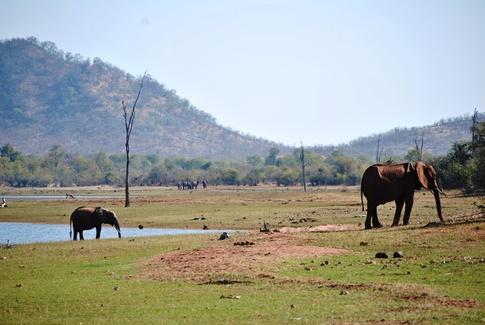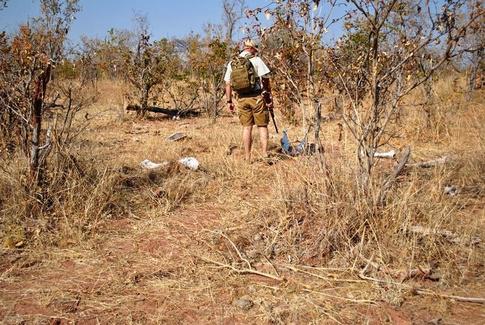This question originally appeared on Quora.
This question originally appeared on Quora. Answer by Rory Young, professional guide, ranger, tracker, and writer with 23 years in wildlife and forest management: The poor old girl in the right of the picture below has a blocked urethra. She was darted and treated by a vet who did what he could, but she continued to decline. Every time I visit this area to train rangers and guides, I both dread being asked to shoot her and also wish I could just end her suffering.
The poor old girl in the right of the picture below has a blocked urethra. She was darted and treated by a vet who did what he could, but she continued to decline. Every time I visit this area to train rangers and guides, I both dread being asked to shoot her and also wish I could just end her suffering.
The poor old girl in the right of the picture below has a blocked urethra. She was darted and treated by a vet who did what he could, but she continued to decline. Every time I visit this area to train rangers and guides, I both dread being asked to shoot her and also wish I could just end her suffering.

Courtesy of Rory Young
Normally, she would travel long distances to get the variety of plant species necessary to get all the nutrients she needs. By not moving, she is eating much less than she needs and also not getting enough nutrients. Furthermore, species such as mopane are known to pump tannins into their leaves making them bitter so as to fend off overbrowsing. More importantly these tannins are not healthy for the poor girl.
Sadly, she is slowly but surely starving to death. It is debatable as to whether she will be shot or euthanized in some other way, as her illness is considered natural and therefore the policy is that nature should take its course.
Either way, it is most likely that she will die on this area of the shore, and her bones will lie there for some time to come.
In that same picture in the distance you can see a group of elephants. Their location is the same as the picture below, where the remains of an elephant that died two years ago are seen. Most likely, they were examining the bones, which is normal behavior for elephants when they come across elephant bones.
In that same picture in the distance you can see a group of elephants. Their location is the same as the picture below, where the remains of an elephant that died two years ago are seen. Most likely, they were examining the bones, which is normal behavior for elephants when they come across elephant bones.

Courtesy of Rory Young
This poor animal was wounded by poachers and moved to the same area before dying on the shore. Most likely, it went to this location for the same reasons: the best food option and close to water.
You can’t see in the picture, but the bones can be found as far away as the small patch of water in the in the upper right hand part of the image.
You can’t see in the picture, but the bones can be found as far away as the small patch of water in the in the upper right hand part of the image.

Courtesy of Rory Young
[PHOTO 3 ABOVE]By contrast, the remains of the elephant in the picture above that was killed by poachers about nine months ago are still all together. When you compare the two pictures, it is easier to see how the bones in the above picture have been more spread out.

Courtesy of Rory Young
All of these sites are within a couple of kilometers of each other. There are others in the same area that died both of natural causes and of course by poachers’ bullets. Over time, the bones get moved by elephants, the elements, and even other animals that gnaw on the small bones to get calcium. These include porcupines, tortoises, and most notably giraffes. (It is quite surprising to come across a giraffe sucking on a bone, believe me. However, giraffes are not found in the area that the pictures were taken, which is the Omay district in the middle Zambezi-Kariba area).
Now imagine you came wandering along a few hundred years ago and had little knowledge of elephant behavior, which was very much the case in the West until very recently, and suddenly you came across numerous scattered bones from a number of different elephants. Considering the reputation elephants have always had for great intelligence, then it would not be unreasonable to assume that the animals had come here to die.
In reality, they came to this place to try and survive but didn’t make it.
Another reason that the myth most likely developed is the mass die-offs during drought periods—especially in arid areas when the few water holes that sustain the elephants have dried up. This has been recorded many times, especially in the Namib desert of Namibia and the Kalahari desert in Botswana.
Lastly, I must add that today elephant graveyards are a tragic reality. They are a result of the sickening and fast-spreading practice of poachers poisoning waterholes.
Most recently, this was done in Hwange National Park in Zimbabwe. I was initially shocked and horrified to hear that 80 elephants had been killed in one incident. However, the number has continued to climb, and recently I learned that the tally has now reached 300 elephants of all ages—complete herds.
Very, very soon there will only be elephant graveyards to be seen and no more living ones.
The Tashinga Initiative in Zimbabwe is a professional and dedicated group fighting with everything they have to save the wildlife within the region.
More questions on Animals: